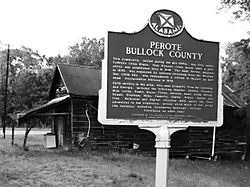Perote, Alabama facts for kids
Quick facts for kids
Perote, Alabama
|
|
|---|---|

The Historic Marker at Perote
|
|
| Country | United States |
| State | Alabama |
| County | Bullock |
| Elevation | 482 ft (147 m) |
| Time zone | UTC-6 (Central (CST)) |
| • Summer (DST) | UTC-5 (CDT) |
| ZIP code |
36061
|
| Area code(s) | 334 |
| GNIS feature ID | 152872 |
Perote is a small, unincorporated community located in Bullock County, Alabama, United States. An "unincorporated community" means it is a place with a shared identity but without its own local government like a city or town.
Contents
History of Perote
Perote has a long and interesting history. It was first settled in the mid-1830s by families mainly from the Carolinas and Georgia.
How Perote Got Its Name
When the community first started, it was called Fulford's Cross Roads. Later, in 1846, a post office was opened there, and the name changed to Missouri Cross Roads.
In 1850, the name Perote was chosen. This name was suggested by soldiers who had fought in the Mexican War (1846–1848). They remembered a strong fort, or "citadel," in Mexico called Perote. The community officially became a town in 1858.
Early Life in Perote
Some of the early families who lived in the area included the Boykins, Reeves, Sellers, and Johnsons. The first buildings in the community were often churches. Both Methodist and Baptist churches were very important.
Much of the social life in Perote centered around these churches. They held special events like "protracted meetings," which were long revivals where people gathered for religious services.
Growth and Decline
Perote grew quickly in the 1850s. By 1860, it was a busy place. There were several doctors, stores, and even a factory that made carriages. The community also had a Masonic lodge and a school.
At the start of the American Civil War (1861–1865), the school had about 150 students. Many young men from the school joined the Perote Guards. This group was formed in 1859 as the country prepared for war. They became part of the 1st Alabama Infantry Regiment. The women of Perote made their uniforms and a flag for them.
After the Civil War, Perote faced challenges. Growing cotton had been the main way people made money, but it became less important. Also, the railroad lines were built in other areas, so Perote was "by-passed" and did not get a train station. Several big fires also damaged the community. Because of these things, businesses and the number of people living in Perote slowly declined.
Population Information
This section shows how the number of people living in Perote has changed over time.
| Historical population | |||
|---|---|---|---|
| Census | Pop. | %± | |
| 1880 | 245 | — | |
| 1920 | 134 | — | |
| 1930 | 143 | 6.7% | |
| U.S. Decennial Census | |||



